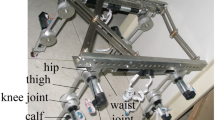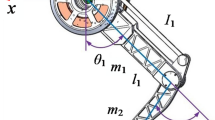Abstract
Quadruped robots consume a lot of energy, which is one of the factors restricting their application. Energy efficiency is one of the key evaluating indicators for walking robots. The relationship between energy and elastic elements of walking robots have been studied, but different walking gait patterns and contact status have important influences on locomotion energy efficiency, and the energy efficiency considering the foot-end trajectory has not been reported. Therefore, the energy consumption and energy efficiency of quadruped robot with trot gait and combined cycloid foot trajectory are studied. The forward and inverse kinematics of quadruped robot is derived. The combined cycloid function is proposed to generate horizontal and vertical foot trajectory respectively, which can ensure the acceleration curve of the foot-end smoother and more successive, and reduce the contact force between feet and environment. Because of the variable topology mechanism characteristic of quadruped robot, the leg state is divided into three different phases which are swing phase, transition phase and stance phase during one trot gait cycle. The non-continuous variable constraint between feet and environment of quadruped robot is studied. The dynamic model of quadruped robot is derived considering the variable topology mechanism characteristic, the periodic contact and elastic elements of the robot. The total energy consumption of walking robot during one gait cycle is analyzed based on the dynamic model. The specific resistance is used to evaluate energy efficiency of quadruped robot. The calculation results show the relationships between specific resistance and gait parameters, which can be used to determine the reasonable gait parameters.
Similar content being viewed by others
References
TOMOYUKI T, AZUMA Y, SHIBATA T. Acquisition of energy-efficient bipedal walking using CPG-based reinforcement learning[C]//IEEE/RSJ Int. Conf. on Intelligent Robots and Systems, St.Louis. USA, October 11–15, 2009: 827–832.
GHORBANI R, WU Q. Adjustable stiffness artificial tendons: conceptual design and energetics study in bipedal walking robots[J]. Mechanism and Machine Theory, 2009, 44(1): 140–161.
MINAKATA H, SEKI H, TADAKUMA S. A study of energy-saving shoes for robot considering lateral plane motion[J]. IEEE Transactions on Industrial Electronics, 2008, 55(3): 1 271–1 276.
ROY S S, PRATIHAR D K. Dynamic modeling and energy consumption analysis of crab walking of a six-legged robot[C]// IEEE Conference on Technologies for Practical Robot Applications, Woburn, MA, April 11–12, 2011: 82–87.
ROY S S, SINGH A K, PRATIHAR D K. Estimation of optimal feet forces and joint torques for on-line control of six-legged robot[J]. Robotics and Computer-Intergrated Manufacturing, 2011, 27(5): 910–917.
ROY S S, PRATIHAR D K. Effects of turning gait parameters on energy consumption and stability of a six-legged walking robot[J]. Robotics and Autonomous Systems, 2012, 60(1): 72–82.
KARA C, BRANDT T, SCHRAMM D. A comparison of static gait patterns for quadrupeds[C]//Proceedings of 12th International Conference on Climbing and Walking Robots and the Support Technologies for Mobile Machines, CLAWAR 2009.
SILVA M F, MACHADO J A T, LOPES A M. Performance analysis of multi-legged systems[C]//Proceeding of the IEEE International Conference on Robotics & Automation, Washington, DC, USA, May 11–15, 2002: 2 234–2 239.
SILVA M F, MACHADO J A T. Energy efficiency of quadruped gaits. Climbing and walking robots[M]. Part 12, 2006: 735–742.
KURAZUME R, YONED K, HIROSE S. 3D sway compensation trajectory for quadruped walking robot[J]. Japan Robotic Institute Journal, 2001, 19(5): 632–637.
KURAZUME R, BYONG-WON A, OHTA K, et al. Experimental study on energy efficiency for quadruped walking vehicles[C]//Proceedings of the IEEE/RSJ International Conference on Intelligent Robots and Systems, Las Vegas, Nevada, October, 2003: 613–618.
HASE T, HUANG Qingjiu. Energy-efficient trajectory planning using inequality state constraint for biped walking robot with upper body mass[C]//Proceedings of the IEEE/RSJ International Conference on Intelligent Robots and Systems, Beijing, China, October 9–15, 2006: 5 913–5 918.
LUO Luping, SHIN K, HAN C. An energy saving power assist manipulator with mechanical elastic elements[C]//3rd International Conference on Mechanical and Electrical Technology, Dalian, China, August 26–27, 2011: 2 359–2 364.
SINGH S P, DUTTA A, SAXENA A. Design of a biped robot with torsion springs at the joints for reduced energy consumption during walk[C]//Proceedings of the ASME 2009 International Design Engineering Technical Conferences & Computers and Information in Engineering Conference(DETC2009-86595), San Diego, California, USA, August 30–September 2, 2009: 1–6.
SCHIEHLEN W, IWAMURA M. Minimum energy control of multibody systems utilizing storage elements[C]//Proceedings of the ASME 2009 International Design Engineering Technical Conferences & Computers and Information in Engineering Conference(DETC2009-86327), San Diego, California, USA, August 30–September 2, 2009: 1–8.
WANG Hongbo, XU Guiling, HU Xing, et al. Dynamics of quadruped walking robot with parallel leg mechanism[J]. Journal of Mechanical Engneering. 2012, 48(23): 76–82.
MAEBA T, MINAMI M, YANOU A, et al. Dynamical analyses of humanoid’s walking by visual lifting stabilization based on event-driven state transition[C]//IEEE/ASME International Conference on Advanced Intelligent Mechatronics, Kaohsiund, Taiwan, China, July 11–14, 2012: 7–14.
LIU Dejun, TIAN Yantao, ZHANG Lei. Energy shaping control of under-actuated biped robot[J]. Journal of Mechanical Engneering, 2012, 48(23): 16–22.
BOMBLED Q, VERLINDEN O. Dynamic simulation of six-legged robots with a focus on joint friction[J]. Multibody System Dynamics, 2012, 28(4): 395–417.
SILVA M F, MACHADO J A T, BARBOSA R S. Complex-order dynamics in hexapod locomotion[J]. Signal Processing, 2006, 86(10): 2 785–2 793.
HYUN K K, WOONG K, KYUNG S R. Biologically inspired energy efficient walking for biped robots[C]//Proceedings of the IEEE International Conference on Robotics and Biomimetics. Kunming, China, December 17–20, 2006: 630–635.
Author information
Authors and Affiliations
Corresponding author
Additional information
This project is supported by National Natural Science Foundation of China (Grant No. 51375289), Shanghai Municipal National Natural Science Foundation of China (Grant No.13ZR1415500), and Innovation Fund of Shanghai Education Commission of China (Grant No.13YZ020)
LEI Jingtao, born in 1970, is currently an associate professor at School of Mechatronic Engineering and Automation, Shanghai University, China. She received her PhD degree from Beihang University, China, in 2007. Her research interests include walking robots, robot modular technology.
WANG Feng, born in 1989, is currently a master candidate at School of Mechatronic Engineering and Automation, Shanghai University, China.
YU Huangying, born in 1989, is currently a master candidate at School of Mechatronic Engineering and Automation, Shanghai University, China.
WANG Tianmiao, born in 1960, is currently a professor at School of Mechanical Engineering and Automatio, Beihang University, China. He received his PhD degree from Northwestern Polytechnical University, China, in 1990. He worked as a postdoctor at National Intelligent Technology and Systems Laboratory of Tsinghua University, China, and Italian National bionic Mechanics Laboratory from 1990 to 1995. His research interests include biomimetic robots, medical robots and robot modular technology of service robots.
YUAN Peijiang, born in 1974, is currently an associate professor at School of Mechanical Engineering and Automation, Beihang University, China. He received his bachelor degree from Tsinghua University, China, in 1997. He received his PhD degree from Western University, Canada, in 2007. His research interests include multi-robot cooperation.
Rights and permissions
About this article
Cite this article
Lei, J., Wang, F., Yu, H. et al. Energy efficiency analysis of quadruped robot with trot gait and combined cycloid foot trajectory. Chin. J. Mech. Eng. 27, 138–145 (2014). https://doi.org/10.3901/CJME.2014.01.138
Received:
Revised:
Accepted:
Published:
Issue Date:
DOI: https://doi.org/10.3901/CJME.2014.01.138




